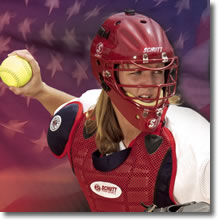In the ever widening world in which we coaches work and live in, you would almost have to be a hermit not to pick up on ideas from other coaches and great players.
As a former catcher and a coach who works with many great catchers nationally, I have always been startled at the numerous types of philosophies that I read or hear about.
Once again, as I have mentioned in previous articles, it should be substance oriented and not stylish. Catching, specifically blocking balls, is a position that has a chance to display bad habits at crucial times more than any other position except for pitching.

Coaches who have come from baseball, or who have listened to baseball coaches, believe that catchers need to be more “up” on their thighs and believe that the proper way to move right or left when blocking balls is to “kick” out their legs.
From 60 feet, there is a good chance that the catcher has time to kick out and then slide across to keep their bodies in front of the ball. There is also a good chance that the catcher is doing this while in the up position (with a runner on base), and not in the pure squat. Well, this great game of fastpitch is played “lower” behind the plate than baseball is.
The one important area we do not have to worry about is runners stealing on the pitcher. The other area we have to concern ourselves with is movement in the down zone.
I see too many catchers “pancaking” the pitch and then trying to stand back up and throw the runners out who are trying to steal. By “pancaking” I mean that the low pitch is caught with the glove fingers over the ball, not underneath it, or the proper way to ensure throwing runners out is by catching the low pitch on the way up. The two ways to ensure catching the drop on the way up is to have great glove position prior to receiving the pitch and staying in the low “pure” squad position.
This does not mean starting the glove out low, it means just prior to release, the glove hand and wrist need to relax and fall a little to ensure a relaxed reaction to the pitch. At the same time, patience must be displayed by the catcher in relation of not trying to reach out for the pitch.
Proper foot position (Slightly staggered will help in getting the body into position quicker) is the key to quickness. With runners on in a stealing position, the catcher needs to have more weight on the front part of the feet. Some catching instructors demand that the weight be forward, or on the insides of the feet. “Soft” weight distribution is essential for quickness and reaction time.
Comfort is always a key. When we are comfortable in our squat, we are letting the ball dictate to us how we are going to approach the throw on the steal. If it is low, we may opt for throwing the runner out from our knees or staying lower longer before coming up into throwing position.
If the pitch is high, we will naturally let the ball bring us into throwing position. It also helps to have an idea WHEN the chances are good that the runner will be going. It is nice when you have a pitch to handle that makes it easier to throw the runners out.
As far as getting into blocking position mark my words, “There is no time to think about kick a leg.”
A catcher’s main concern is to get her body in front of the pitch and smother it. We use a slide or a “jump” slide into the position that is optimal for blocking balls. We also tell our catchers that the pitcher is more inclined to throw a bad pitch down than they are up. So the predetermined bad area is low. What gets us over to the ball quicker? In discussion with widely respected Bill Edwards (head coach at Hofstra), we came to the agreement that the hands are the quickest tools an athlete has.So, why don’t we try and get the hands to our “spot” where the bad pitch is going? We should because where the hands go the body will follow. This does not meant that we are trying to catch the bad ball, all it means is that the hands are leading our body into blocking position. Whatever method you teach, the bottom line is to get to the “spot” ASAP. Remember that efficient movement in catching, throwing and blocking can only be made effective by repetition.